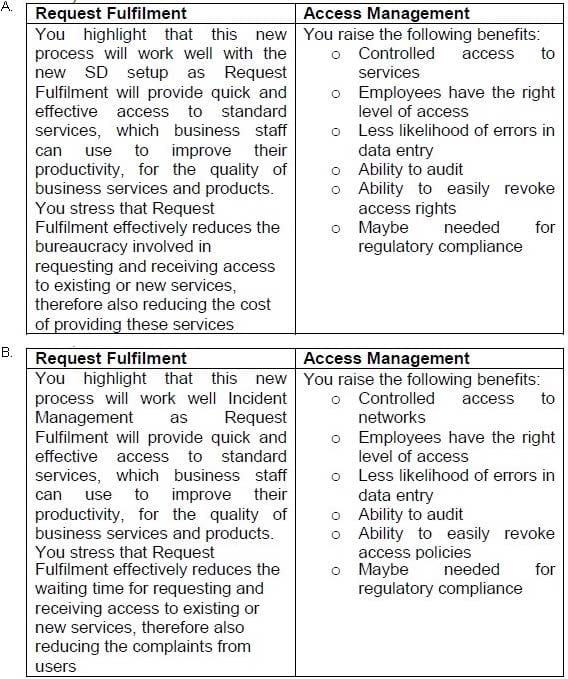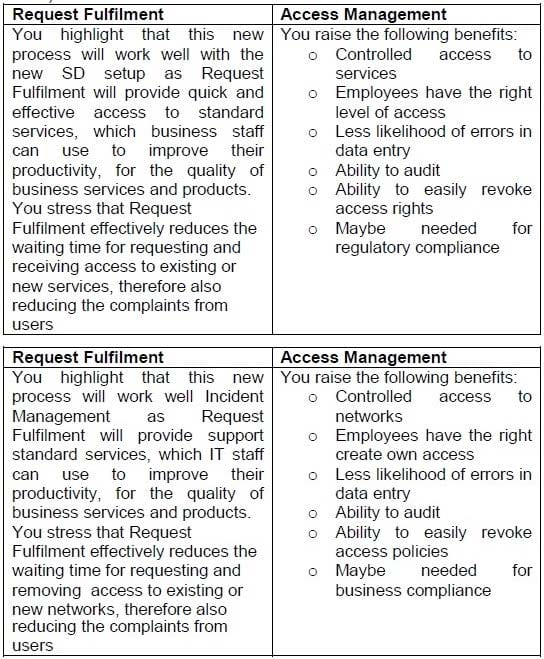
ITILSC-OSA Exam Questions & Answers
Exam Code: ITILSC-OSA
Exam Name: ITIL Service Capability Operational Support and Analysis Exam
Updated: Apr 28, 2024
Q&As: 26
At Passcerty.com, we pride ourselves on the comprehensive nature of our ITILSC-OSA exam dumps, designed meticulously to encompass all key topics and nuances you might encounter during the real examination. Regular updates are a cornerstone of our service, ensuring that our dedicated users always have their hands on the most recent and relevant Q&A dumps. Behind every meticulously curated question and answer lies the hard work of our seasoned team of experts, who bring years of experience and knowledge into crafting these premium materials. And while we are invested in offering top-notch content, we also believe in empowering our community. As a token of our commitment to your success, we're delighted to offer a substantial portion of our resources for free practice. We invite you to make the most of the following content, and wish you every success in your endeavors.

Download Free ITIL ITILSC-OSA Demo
Experience Passcerty.com exam material in PDF version.
Simply submit your e-mail address below to get started with our PDF real exam demo of your ITIL ITILSC-OSA exam.
![]() Instant download
Instant download
![]() Latest update demo according to real exam
Latest update demo according to real exam
* Our demo shows only a few questions from your selected exam for evaluating purposes
Free ITIL ITILSC-OSA Dumps
Practice These Free Questions and Answers to Pass the ITIL Certification Exam
What is the difference between a Known Error and a Problem?
A. The underlying cause of a Known Error is known. The underlying cause of a Problem is not known
B. A Known Error involves an error in the IT infrastructure, A
C. Problem does not involve such an error.
D. A Known Error always originates from an Incident. This is not always the case with a Problem
E. With a Problem, the relevant Configuration Items have been identified. This is not the case with a Known Error.
Scenario
You are the CIO of a large stockbroking firm, based in Hong Kong.Recently this company has acquired two other major firms in Londonand New York. Total Company staff now exceeds 800 people. EachFirm currently has their own Service Desk.
Hong Kong has 10 SD staff to 400 employees, with 6 2nd level support staff London has 3 SD staff to 140 employees with 3 2nd level support staff New York has 5 SD staff to 250 employees with 5 2nd levelsupport staff
With this new merger comes new support issues. Complaints arecoming in to say that there si an imbalance with ratio of IT supportstaff to users, Service Desks in London and New York are havingtrouble knowing and supporting new systems which has resulted inusers calling Hong Kong Service Desk. This has resulted in higherresolution times and an inability to get through to the service deskThe Business is not happy with the current situation.
Refer to the scenario.

A. B.
C.
D.

The success of Service Operation phase is based on some importantCritical Success Factors. From the options below, which would bethe most important for Service Operation?
A. Management support for using phase Business support to ensure users use Service Desk as little aspossible Champions to drive process
usage
Staffing and retention of Service Desk
Service management usage
Suitable tools ?especially Incident Management
Measurement and reporting of capacity
B. Management support for setting up phase Business support to ensure users call Service Desk Champions to lead process implementation Staffing and retention of Service Desk Service management training Suitable tools Measurement and reporting of usage
C. Management support for setting up SD Business support to ensure users call Service Desk Champions to lead Service Support Staffing and retention of Service Desk Service management understanding Suitable tools ?especially Service Desk Measurement and reporting
D. Management support for setting up phase Business support to ensure users use Service Desk Champions to lead process implementation Staffing and retention of Service Desk Service management training Suitable tools ?especially Service Desk Measurement and reporting
Scenario
Brewster's is a toy factory that has been in business for 30 years.The company started with a small family
run shop and has grownconsistently over the years. They are now supplying toy storesnationwide and are
considered to be the primary supplier of children'scollectable novelty erasers.
Brewster's IT department is relatively small (currently 15 staff) butefficient. They have recently employed
an IT Manager in an attemptto improve the management of the infrastructure, as well as moreeffective use
of resources and identification of areas for improvement.
The Brewster's management teams do not have a lot of ITknowledge. The newly appointed IT Manager is
very ITIL focusedand wants to implement as many ITSM processes as is appropriatethere are currently no
formal processes in place. On starting with thecompany the IT Manager completed an internal assessment
of the ITinfrastructure ?including staff skills analysis, and collated the resultsfrom customer satisfaction
surveys completed over the last 5 years.
The main areas of concern are as follows:
Responses from customer satisfaction survey:
Overall a consistent satisfaction level. However, responses completed during the past 12 months show an
increase in customers who were unsatisfied with call waiting times when contacting the service desk for
help with online orders and requests for information.
Customers added the following additional comments:
"Never get to speak to the same person twice when dealing with an Incident number, had to call several
times to receive follow up on progress" "Some of the Service Desk staff seem under qualified to deal with
my questions about new applications/incidents/service requests"
Results from Staff Skills Analysis:
Staff, in general, have a good knowledge of IT systems and a basic understanding of the business
processes and objectives. However, staff are not well informed of upcoming releases of new or changed
services and not given adequate information to relay to the customers.
Staff added the following additional comments:
"Communication between Service Operation departments has become inefficient - there are meetings for
the sake of meetings, but the important information we need to know to do our day to day jobs is lacking"
"I still don't know what half of the people do, that work in the IT department!"
Results from General IT Infrastructure assessment:
Lack of event monitoring and planning
Lack of input from Operational Support departments into Service Design Lack of skill and information
sharing across the Operational Support teams with regards to Incident, Problem, Workarounds and Known
Error data. Little to no proactive activities being carried out.
Refer to Scenario
Through further investigation you identify that there is no formalmeans of collecting data to identify service
improvement, other thancustomer surveys. These are very subjective and do not give abalanced picture
regarding quality of service. Through discussions with the Continual Service ImprovementManager, you
decide to start collecting a range of metrics to helpidentify service improvements.
Which metrics would be relevant to Service Desk?
A. % of calls resolved by Service Desk Average time to identify incident Average time to escalate incident % of user updates conducted within target times Customer feedback Average Service Desk cost of handling incident
B. % of calls resolved by Service Desk Averagetime to resolve incident Averagetime to escalate incident % of customer updates conducted within target times Customerfeedback AverageService Desk cost of handling incident
C. o % of calls answered by Service Desk Averagetime to escalate incident % of customer updates conducted within Service Deskhours Customerfeedback Averagecost of handling incident
D. % of calls answered by Service Desk Averagetime to resolve problems Averagetime to escalate problem % of customer updates conducted within Service Desktimes Customerfeedback Averagecost of handling problem
Operations Control refers to?
A. The managers of the Event and Access Management Processes
B. Overseeing the monitoring and escalating of IT operational events and activities
C. The tools used to monitor the status of the IT Network
D. The situation where the Service Desk manager is required to monitor the status of the infrastructure when Service Desk Operators are not available
Viewing Page 2 of 3 pages. Download PDF or Software version with 26 questions

